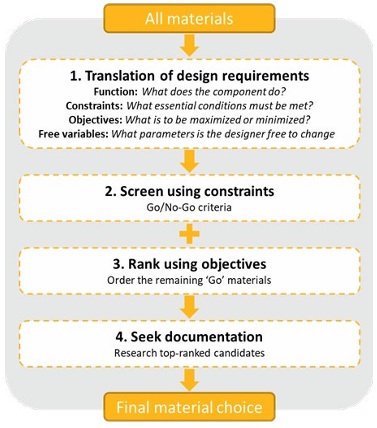The Granta EduPack White Paper on Materials Selection, authored by Harriet Parnell, Kaitlin Tyler, and Mike Ashby, presents a practical and educational guide to selecting materials in engineering design. Developed by Ansys and based on Ashby’s well-known methodologies, the paper outlines a four-step process to help learners and professionals select materials that meet performance, cost, and functional requirements using the Granta EduPack software.

The materials selection methodology begins with translation, the process of converting a design problem into precise engineering terms. This involves four components: function, constraints, objectives, and free variables. The function describes what the component must do—such as support loads, conduct heat, or resist pressure. Constraints are strict conditions that must be met, such as minimum strength, maximum service temperature, or corrosion resistance. Objectives define what is to be minimized or maximized—typically weight, cost, energy loss, or thermal conductivity. Finally, free variables are parameters the designer is allowed to adjust, such as the material choice itself or geometric dimensions. Defining these clearly is essential for identifying suitable materials later in the process.
The second step is screening, which eliminates materials that do not meet the basic constraints identified during translation. If a material doesn’t meet the required temperature, stiffness, or conductivity, it is screened out. Screening can be done manually by checking material databases, but the Granta EduPack software provides tools for a more visual approach. Using property charts with logarithmic scales, users can apply filters and quickly identify which materials fall outside the necessary limits. These visualizations make it easier to compare large material datasets and help narrow down potential candidates.
After unsuitable options are removed, the ranking step evaluates the remaining materials based on how well they meet the design objectives. This involves using performance indices, which are combinations of material properties that reflect the overall performance for a given function. For instance, if the goal is to design a lightweight and stiff beam, the relevant performance index could be the square root of Young’s modulus divided by density. The better this index, the more suitable the material. These indices can be plotted on property charts within EduPack to show which materials perform best. Materials above the selection line, or toward a defined optimal region, are considered the top choices.
The final step is documentation, where the designer further investigates the top candidates. Even if a material performs well according to data, real-world concerns like manufacturing limitations, environmental impact, availability, and historical reliability must also be considered. This step emphasizes broader engineering judgment and the importance of context in final decision-making.
Following the methodology section, the white paper explains how performance indices are derived. They come from the performance equation, which relates the function of the component, its geometry, and the material properties. If the variables in the equation can be separated into those three groups, the material-dependent part becomes the performance index. This index can then be used universally across different geometries and loading scenarios, simplifying the selection process early in design.
Two examples demonstrate how performance indices are formed. In the first, a thermal storage material must store maximum heat per unit cost. The index becomes heat capacity divided by material cost. In the second, a beam must be light and stiff under bending. The derived performance index combines modulus and density. These examples show how specific requirements and constraints lead to practical, optimized material choices.
Granta EduPack supports these concepts through its interactive features. Users can plot performance indices as selection lines with defined slopes on charts or use indices as axes to rank materials visually. The Performance Index Finder tool automates the index derivation process by letting users input their function, constraints, objectives, and free variables directly. The software then produces a relevant performance index and displays suitable materials accordingly.
The paper concludes with a list of references and educational resources. Ashby’s textbook Materials Selection in Mechanical Design is cited as the foundational source. Additional resources include Ansys Innovation Courses, video tutorials, and downloadable case studies focused on mechanical, thermal, and electromechanical applications. These are intended to reinforce the material and support both independent learning and classroom instruction.
In summary, this white paper offers a clear, structured, and practical approach to materials selection. It not only teaches the methodology behind choosing the right materials but also integrates powerful software tools that make the process faster and more intuitive. By combining theoretical rigor with real-world practicality, the Granta EduPack methodology equips students and engineers with the skills to make informed, optimized, and sustainable material choices.
You can download the paper here.
Also Read:
ML and Multiphysics Corral 3D and HBM
A Master Class with Ansys and Synopsys, The Latest Advances in Multi-Die Design
Share this post via:






Comments
There are no comments yet.
You must register or log in to view/post comments.